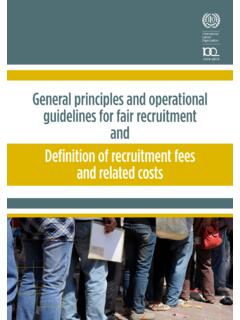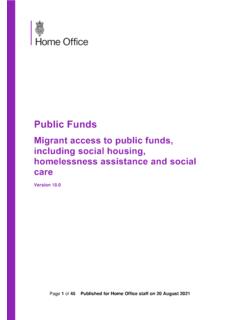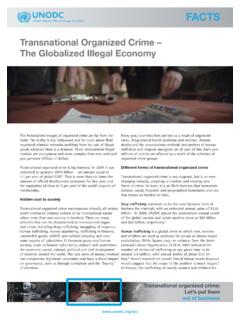Transcription of International Migration 2019 - United Nations
1 0204060801001201401601802001950195519601 9651970197519801985199019952000200520102 015 Number of States Parties1951 Refugee convention1967 Refugee protocol1990 Migrant workers convention2000 Human trafficking protocol2000 Migrant smuggling protocol1949 ILO Migration for employment convention (No. 97)1975 ILO migrants workers convention (No. 143)2011 ILO Domestic workers convention (No. 189)InternationalMigration2019 Report This page is intentionally left blank. ST/ Department of Economic and Social Affairs Population Division International Migration 2019 Report United Nations New York, 2019 The Department of Economic and Social Affairs of the United Nations Secretariat is a vital interface between global policies in the economic, social and environmental spheres and national action.
2 The Department works in three main interlinked areas: (i) it compiles, generates and analyses a wide range of economic, social and environmental data and information on which States Members of the United Nations draw to review common problems and take stock of policy options; (ii) it facilitates the negotiations of Member States in many intergovernmental bodies on joint courses of action to address ongoing or emerging global challenges; and (iii) it advises interested Governments on the ways and means of translating policy frameworks developed in United Nations conferences and summits into programmes at the country level and, through technical assistance, helps build national capacities.
3 The Population Division of the Department of Economic and Social Affairs provides the International community with timely and accessible population data and analysis of population trends and development outcomes for all countries and areas of the world. To this end, the Division undertakes regular studies of population size and characteristics and of all three components of population change (fertility, mortality and Migration ). Founded in 1946, the Population Division provides substantive support on population and development issues to the United Nations General Assembly, the Economic and Social Council and the Commission on Population and Development.
4 It also leads or participates in various interagency coordination mechanisms of the United Nations system. The work of the Division also contributes to strengthening the capacity of Member States to monitor population trends and to address current and emerging population issues. Notes The designations employed in this report and the material presented in it do not imply the expression of any opinions whatsoever on the part of the Secretariat of the United Nations concerning the legal status of any country, territory, city or area or of its authorities, or concerning the delimitation of its frontiers or boundaries. The term country as used in this report also refers, as appropriate, to territories or areas.
5 This report is available in electronic format on the Division s website at For further information about this report, please contact the Population Division, Department of Economic and Social Affairs, United Nations , Two United Nations Plaza, DC2-1950, New York, 10017, USA; phone: +1 212-963-3209; email: Suggested citation: United Nations , Department of Economic and Social Affairs, Population Division (2019). International Migration 2019: Report (ST/ ). Official symbols of United Nations documents are composed of capital letters combined with numbers, as illustrated in the above citation. Published by the United Nations Sales no.: ISBN: 978-92-1-148338-3 eISBN: 978-92-1-004819-4 Copyright 2019 by United Nations , made available under a Creative Commons license (CC BY IGO) International Migration 2019: Report United Nations Department of Economic and Social Affairs | Population Division iii PREFACE In the area of International Migration , the Population Division estimates the global number of International migrants at regular intervals, monitors levels, trends and policies of International Migration , and collects and analyses information on the relationship between International Migration and development.
6 As part of these monitoring activities, the Migration and Urbanization Section within the Population Division maintains the United Nations Global Migration Database, which contains the most complete set of statistics on International migrants enumerated in countries or areas and classified by age, sex and country/area of birth or citizenship. The Population Division participates on behalf of the Department of Economic and Social Affairs (DESA) in the Executive Committee of the United Nations Network on Migration . It also services the intergovernmental process on International Migration and development at the General Assembly and acts as the focal point within the United Nations Secretariat for the State-led Global Forum on Migration and Development (GFMD).
7 This report presents information on levels and trends in International Migration , including refugees and asylum seekers, for regions and countries of the world, the state of International Migration policies of the Member States, and the ratification and adoption status of Migration -related legal instruments and normative frameworks. The data for the International migrant stock are taken from the International Migrant Stock 2019 ( United Nations , 2019a). The data can be downloaded at The estimates on the total population are based on the World Population Prospects 2019 ( United Nations , 2019b). These data can be downloaded at The estimates on net Migration and the projected population up to 2070 presented in chapter II are also based on World Population Prospects 2019.
8 Chapter III showcases the current state of International Migration policies of the Member States based on data collected through the International Migration module (module III) of the United Nations Twelfth Inquiry among Governments on Population and Development ( ). Chapter IV provides an analysis of the status of ratification (by Member States) of the Migration -related legal instruments of the United Nations and the International Labour Organization (ILO), based on information from the United Nations Treaty Section ( ) and the NORMLEX Information System on International Labour Standards ( ), as well as the status of the adoption of Migration -related normative frameworks of the United Nations , namely the global compacts for safe, orderly and regular Migration ( ) and on refugees ( ).
9 For more information on the data and methodology used for calculating the various indicators used in this report, please see the above-mentioned publications. The present report has been issued without formal editing. Responsibility for this report rests with the Population Division. More information on the activities of the Population Division in the area of International Migration can be found at International Migration 2019: Report iv United Nations Department of Economic and Social Affairs | Population Division KEY FINDINGS 1. In 2019, the number of International migrants worldwide reached nearly 272 million, up from 153 million in 1990 Europe hosts the largest number of International migrants (82 million), followed by Northern America (59 million) and Northern Africa and Western Asia (49 million).
10 The regional distribution of International migrants is changing, with migrant populations growing faster in Northern Africa and Western Asia and in sub-Saharan Africa than in other 2. Forced displacements across International borders have continued to rise The global number of refugees and asylum seekers has increased by about 13 million between 2010 and 2017,2 accounting for close to a quarter of the increase in the number of all International migrants . Northern Africa and Western Asia host around 46 per cent of the global number of refugees and asylum seekers, followed by sub-Saharan Africa (close to 21%). 3. Most of the world s migrants live in a relatively small number of countries In 2019, two thirds of all International migrants were living in just 20 countries.


















